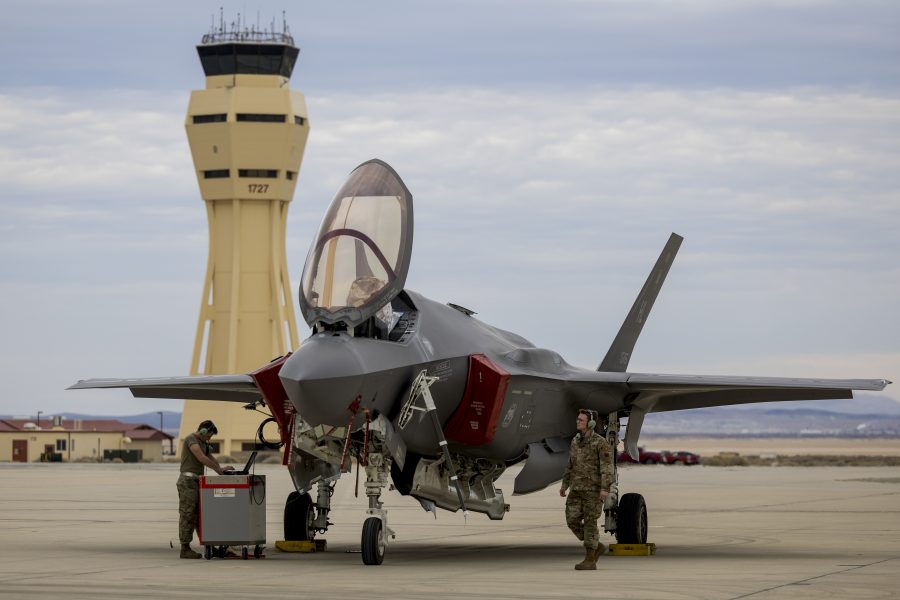The U.S. Air Force is struggling, and in important ways failing, to deal with the deluge of data that new digital flight systems are producing, missing out on the “decisive advantage” it could supply if properly utilized, the service’s vice chief told industry leaders Feb. 29.
In his first public comments since being sworn in Dec. 29, Gen. James Slife offered a negative assessment of the service’s tools, processes, and skills to take advantage of its own data—at the expense of potential benefits to training, operations, maintenance and logistical systems.
“We’re not at all organized, educated [or] trained, … we don’t have the right policies, we are wholly out of position to be able to take advantage of this,” Slife said at a lunch event hosted by the D.C. chapter of the defense vendors’ trade association AFCEA.
As a result, he said vast quantities of uncategorized, unindexed data were being dumped into the service’s cloud-based data lakes. “These data lakes have more unusable data than that which is actually usable,” Slife said, adding that, as a result, they’ve “become data swamps … with more uncategorized, uncatalogued information than any machine or human could use.”
Slife gave three specific examples of these failures, saying the Air Force could not:
- Transmit, index, catalog, and use most of the huge data troves generated and recorded from the F-35.
- Record the data that flows between the flight controls, navigation systems and communications equipment on C-17 cargo planes and other Air Force aircraft.
- Centrally compile maintenance data that would provide warning about anticipated failures of low break-rate parts, which have to be manufactured in advance.
The F-35 in particular has been described as “a computer that happens to fly.” The aircraft’s flight systems, like its on-board radar, electronic warfare tools, and electro-optical targeting system, “provide a detailed, cohesive image of everything that [the plane] sees and senses,” explained Slife. All that data, many terabytes from each mission, are recorded in real time on a hard drive stored on the aircraft.
”There’s lessons learned built into that,” said Slife, “There’s mistakes than can be learned from in there, there’s the bad radio call, there’s the signal we’ve never seen before.” That data could be used “to feed our algorithms, to power accurate AI models.”
The problem, Slife said, is that “there is a high probability that every bit of that valuable data will never ever see the light of day. It will all be deleted and we’ll record over it the very next day.”
One reason is the sheer volume of that data is too much to transmit across the Air Force network.
“These files are too big for data piping between bases. That means we have to task our Airmen to hand carry hard drives [from base to base],” Slife said. Once the data arrives, it has to be indexed and categorized: “That’s a human job, manpower intensive,” which involves trimming “hours of transit time, unbroken horizon video footage where you’re just droning from point A to point B,” he said. It can take weeks.
There is also a problem with over-classification. As an example, Slife described a mission on which there is a single radio message about a B-21 taking off. “Now that whole mission [recording] … is classified at a top secret level” and can’t be used for training, he said.
“Frankly, our own culture of over-classification and protecting data past the point at which we lose the ability for it to become operationally relevant is part of the problem,” he said.
F-35 missions aren’t the only missed opportunities for the service, Slife added. Even on pre-digital age aircraft like the C-17 cargo plane, the flight systems are a rich source of data. All that data flows across the serial bus, a military standard part in every NATO aircraft known as the 1553 data bus that acts as a sort of telephone exchange for the plane’s various systems—flight, navigation and weapons—to communicate with each other.
“Every microscopic adjustment [of the flight systems] can be captured and stored, allowing for better mission reconstruction and more accurate aircraft data,” Slife said. “Failing parts can be identified earlier, cyber attacks can be detected,” but only if “we capture and use the data and if it is at our very fingertips. Right now if we’re not getting a single bit of it.”
Finally, Slife lamented the absence of a centralized mechanism for collecting and analyzing maintenance data. This would be especially valuable for so-called low break-rate parts—pieces of the aircraft that very rarely need replacing.
Older aircraft like the F-15 are just starting to have such parts fail, “and in many cases, we have no modern stockpile of those parts,” Slife said. It takes months or even years to recreate production lines for parts that haven’t been manufactured for so long, so the advance warning provided by maintenance records was vital.
“Right now, we don’t have any idea how many of those things we need and how often they will break,” Slife said.
The service does have maintenance data for those aircraft, “but it’s spread across multiple databases in multiple different organizations that don’t talk to each other. All the data is bifurcated and sent to different agencies around the Air Force and it’s too split up and disaggregated to allow us to make any predictions about the future,” he said.
To address these problems, Slife declared that he would become the “chief enforcer” for the service’s chief data officer: “I’m going to spend the next X number of years kind of being the designated hammer inside the Air Force on this topic,” he said. “We’ve got a long way to go.”

